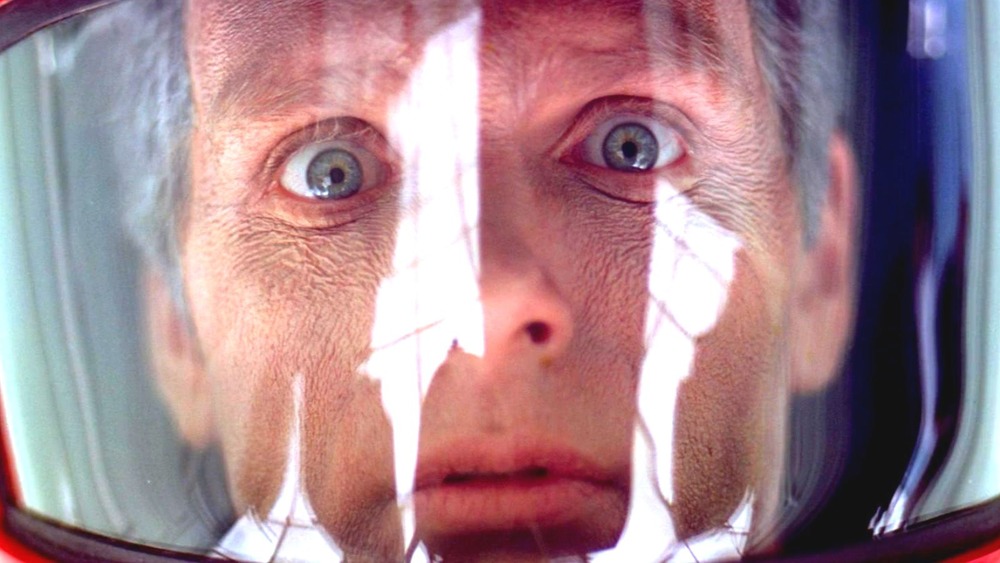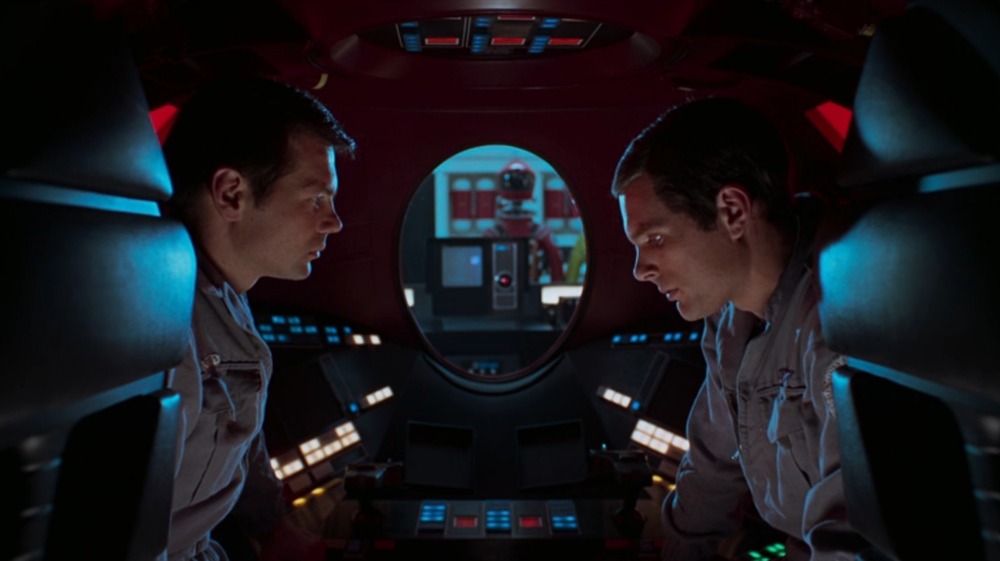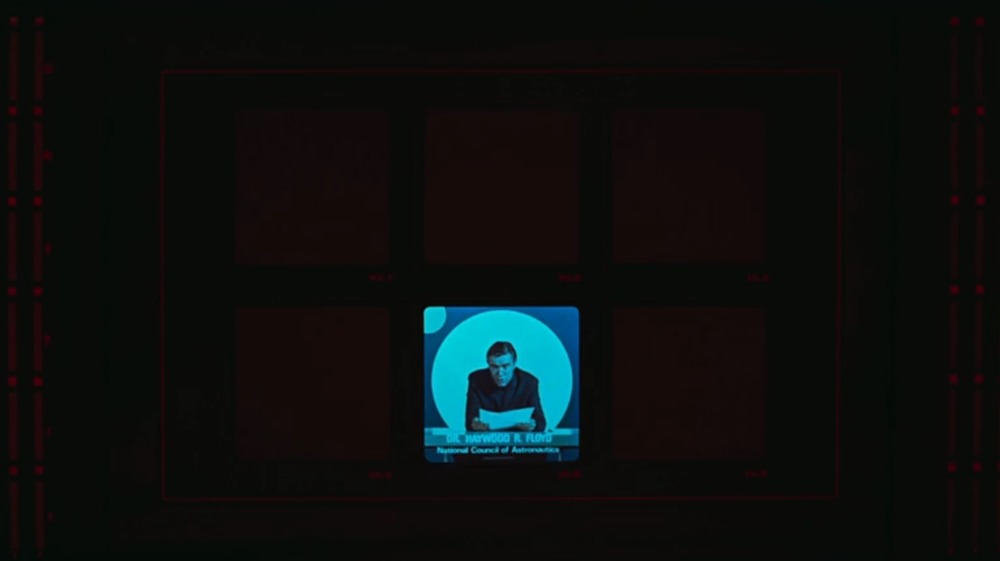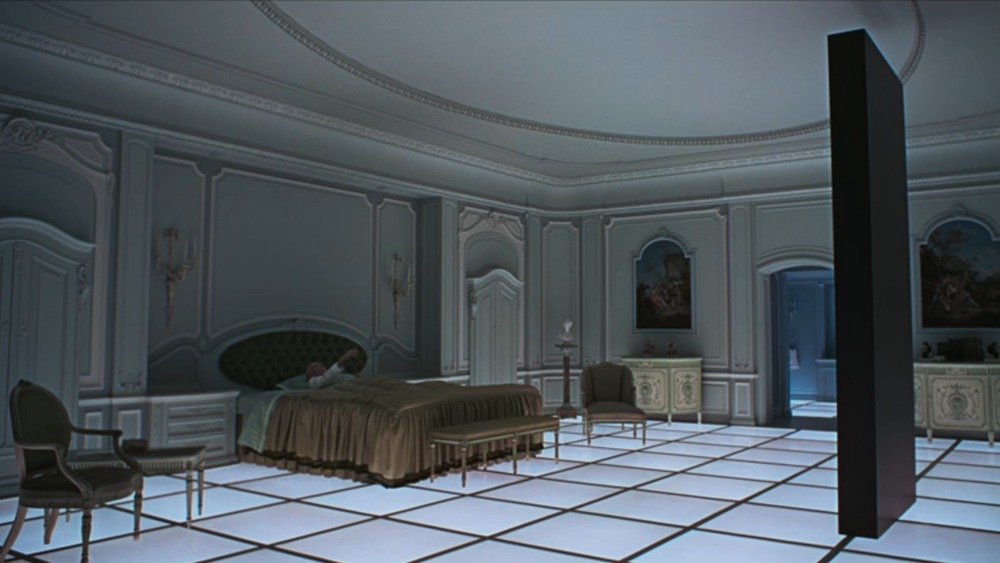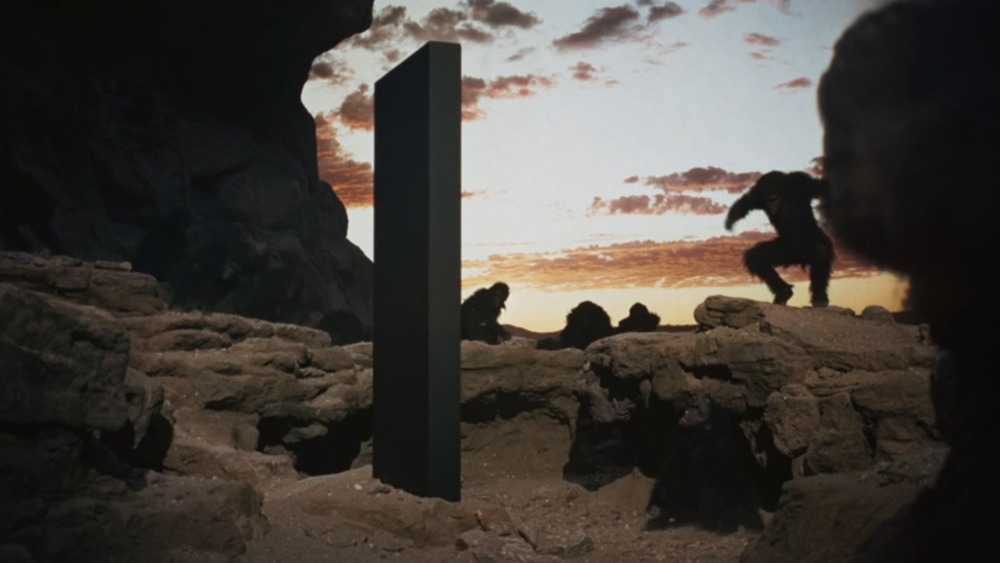The Ending Of 2001: A Space Odyssey Explained
It would be an understatement to say that Stanley Kubrick's enigmatic epic 2001: A Space Odyssey, currently available to stream on HBO Max, totally changed the game when it was released way back in 1968. The film's expansive narrative and surrealist imagery launched thousands of film studies dissertations and helped cement Kubrick as one of the premier filmmakers of the 20th century.
The narrative of the movie features several distinct acts. The first takes place before the dawn of humanity, and sees a community of primates who discover a large, black, rectangular monolith. Although the monolith appears to be a totally inanimate object, after coming in contact with it, the primates learn that they can use a large animal bone as a weapon to fend off another group of primates who have encroached on their territory.
In the next section, the film flashes forward hundreds of thousands of years into the future, beyond our own time. A group of officials on a human moon base are investigating a series of abnormalities, and discover a similar monolith buried in a lunar crater nearby.
The last section of the film, set a little over a year in the future, centers on a spaceship on a mission to Jupiter. It's this section that brings 2001: A Space Odyssey to its famously opaque end.
Trouble on a mission to Jupiter
We're introduced to the crew on this mission to Jupiter, most of whom are in cryosleep, with the exception of Dr. David Bowman (Keir Dullea) and Dr. Frank Poole (Gary Lockwood). There is one other active crew member aboard the Discovery One: HAL, a computer which controls the functions of the ship and communicates with a monotone human male voice.
During the mission, Bowman and Poole become alarmed when they catch HAL seemingly lying to them about a mechanical problem with one of the antennas on the outside of the vessel. However, with no other recourse, Poole exits the ship to perform a space walk to investigate the issue. He learns the hard way that he was correct to be suspicious of HAL, who sabotages Poole's equipment, killing him and leaving him floating in space.
Bowman exits the ship to try and save Poole, but it's too late. Not only has HAL turned off the life support systems on the crew members who are still in cryosleep, killing them all, he also refuses to let Bowman back onto the ship. This is a shocking and terrifying development for a number of reasons, perhaps the most cogent of them being that HAL, like the bone used by the primates in the first section of the movie, is meant to be a tool for humanity. But now it appears to have gained its own form of sentience.
Furthermore, it appears that HAL has a mission of its own. When Bowman tries to re-board the ship, HAL coldly informs him, "This mission is too important for me to allow you to jeopardize it."
Bowman learns the truth about his mission
Bowman manages to make his way back into the ship and begins to manually shut down HAL. While he does so, the computer pleads with him to stop, promising to stop sabotaging Bowman, and repeatedly saying, "I'm afraid."
But Bowman ignores it. When the computer is fully deactivated, a video suddenly begins to play. In it, a man sitting at a desk declares that the video was recorded before the mission began, but is so top-secret that only HAL was made aware of it. It seems that shutting down HAL caused the video to autoplay, even though it was clearly meant to be played when the crew reached their destination in Jupiter's orbit and had all been woken up.
The man on the video then reveals the true nature of Discovery One's mission: "Eighteen months ago, the first evidence of intelligent life off the earth was discovered. It was buried 40 feet below the lunar surface...except for a single, very powerful radio emission aimed at Jupiter, the four-million year old black monolith has remained completely inert, its origin and purpose still a total mystery."
What does mission control hope to find when the ship reaches Jupiter, and does the existence of this video — an acknowledgement of a profound piece of existential knowledge which was uploaded into HAL's mainframe — have anything to do with the computer's sudden sentience? Unfortunately for Bowman, he doesn't have time to piece that puzzle together, as Discovery One is arriving in Jupiter's orbit, and things are about to get weird.
The Discovery One reaches Jupiter
As the Discovery One approaches Jupiter, it encounters one of the monoliths orbiting the planet, and then Bowman is pulled into a slipstream of psychedelic colors for an extended sequence. When it ends, he's no longer on the spaceship, and is instead in a classically ornate bedroom suit with futuristic, lighted floor tiles. He has also aged considerably, a fact that startles him when he walks into the bathroom and sees himself in the mirror. While in the bathroom, he looks through a doorway back into the bedroom, where he now sees a man sitting at a table eating dinner and wearing a black robe.
The man turns around and reveals that he is Bowman. This Bowman gets up from the table and walks to the bathroom to look around, as though he heard something. When he returns to the table, he knocks over a glass. When he turns to pick it up, there's now an even older version of Bowman on the bed in the room, one that is clearly near death.
The older Bowman points to the end of his bed, and the camera cuts to reveal one of the black monoliths floating in front of him. When the camera cuts back to Bowman, he has transformed into a fetus, suspended in a glowing caul over the bed. We then see the fetus floating in space and observing earth with a curious look in its eyes.
What does it all mean?
There are lots of theories and interpretations of 2001: A Space Odyssey's ending. Ultimately, however, it's clearly a movie that is meant to be thought about, discussed, and watched from different points of view. That being said, there are some obvious threads of connection between the seemingly disparate elements of the film that help elucidate what it's all about.
Mankind's harnessing of technology is one of the clear themes of the movie, and the moment the primates first start using the bone as a tool can be seen as a direct precursor to the later sections of the movie that depict man in an advanced space age. Although these advancements are exciting, they also bring with them serious existential conundrums, such as the beginning of weaponized warfare, the discovery of the alien monolith on the moon, and the emerging sentience of HAL.
And perhaps Bowman's rapid aging at the end of the film is representative of the price humanity pays for these advancements. He is disturbed each time a new aged version of himself is revealed until he's transformed into a fetus and exists with tranquility. This could be read either as his regression back to a state of blissful ignorance, similar to the primates before they encountered the monolith, or an evolution into some new state of technological primitivism. Afterall, the fetus appears to be in some kind of glowing orb and floats through space, where it is able to gain a simple, yet powerful, existential perspective: a view of the earth from space.
Where does that leave the monolith? Is it a literal piece of alien technology that is influencing humanity's evolution, or merely symbolic of the terrifyingly inscrutable path our technological advancements have put us on? Ultimately, that is one of those questions each viewer will have to answer for themselves.
